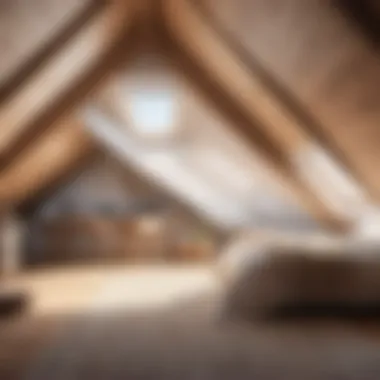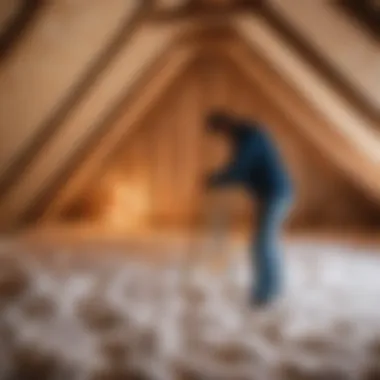Materials:
- Fiberglass insulation rolls: 10 rolls of R-38 (measurements: 16 inches wide x 48 inches long)
- Vapor barrier: 1 roll of 4 feet wide x 100 feet long
- Utility knife for insulation cutting
- Safety goggles and gloves
- Face mask
- Tape measure
- 2x4 boards for creating barriers
DIY Steps:
-
Preparation:
- Measure the attic space to determine the required amount of insulation.
- Ensure proper ventilation and check for any air leaks that need sealing.
- Put on safety gear.
-
Installing Insulation:
- Roll out the fiberglass insulation between the joists, ensuring a snug fit without compressing it.
- Cut the insulation using a utility knife to fit around obstacles such as wiring or vents.
-
Vapor Barrier Installation:
- Unroll the vapor barrier and place it over the insulation, ensuring full coverage and sealing with tape.
- Trim any excess vapor barrier material.
Technical Aspects:
- Tools: Safety gear, utility knife, tape measure
- Timing: Depending on the attic size, installation may take between 4 to 8 hours
- Critical Techniques: Properly cutting and fitting insulation, securely sealing the vapor barrier
DIY Project Process:


-
Installing Insulation:
- Begin by rolling out the first insulation layer parallel to the joists, continuing until the entire attic floor is covered.
- Use 2x4 boards to create barriers around attic access points to prevent insulation from spilling over.
-
Vapor Barrier:
- Install the vapor barrier by starting at one end of the attic and working your way across, ensuring no gaps or overlaps.
- Seal seams and edges securely with tape to prevent moisture penetration.
Troubleshooting Tips:


- If insulation is too thick, it can compress and lose effectiveness; ensure a snug fit without overcompression.
- Check for any gaps in the vapor barrier and reseal as needed to maintain efficiency.
Factors Influencing Attic Insulation Costs


In the realm of optimizing attic insulation, understanding the factors that influence costs is paramount to making informed decisions about enhancing energy efficiency and cutting down on heating and cooling expenses. Several key elements play a crucial role in determining the overall cost of attic insulation, including the type of insulation material, insulation R-Value, attic size and layout, labor costs, and additional materials and equipment. By comprehensively examining these factors, homeowners can embark on a strategic approach towards improving their home's insulation system.
Type of Insulation Material
Fiberglass Insulation
Fiberglass insulation is a prevalent choice in attic insulation due to its thermal performance and cost-effectiveness. Its ability to resist moisture and mold growth makes it a popular option. However, fiberglass insulation may require careful handling during installation to prevent skin irritations. Understanding its benefits and drawbacks, homeowners can assess whether fiberglass insulation aligns with their insulation needs.
Cellulose Insulation
Cellulose insulation, made from recycled paper materials, offers excellent thermal performance as well as soundproofing qualities. Its eco-friendly composition makes it an attractive choice for environmentally conscious homeowners. However, it is crucial to address potential settling concerns with cellulose insulation to maintain its effectiveness over time.
Spray Foam Insulation
Spray foam insulation provides a seamless air barrier, reducing energy losses due to air infiltration. Its expansion properties allow it to fill gaps and cavities effectively. While spray foam insulation offers superior thermal resistance, it requires professional installation due to its application complexity.
Radiant Barrier Insulation
Radiant barrier insulation reflects heat instead of absorbing it, making it ideal for hot climates to minimize radiant heat gain. Its installation typically involves placing it on attic surfaces facing the roof. By understanding its unique features, homeowners can decide if radiant barrier insulation suits their insulation requirements.
Insulation R-Value
Understanding R-Value
The R-Value measures insulation material's resistance to heat transfer, with higher values indicating greater insulating effectiveness. Understanding R-Value implications assists homeowners in selecting insulation materials based on their energy efficiency goals. By grasping this concept, individuals can tailor their insulation choices to meet their specific attic insulation needs.
Determining Required R-Value
Determining the required R-Value for attic insulation involves considering factors such as climate, desired energy efficiency, and building codes. Calculating the optimal R-Value ensures that the insulation performs efficiently in maintaining comfortable indoor temperatures throughout the year. By evaluating this aspect, homeowners can optimize their insulation investment for long-term energy savings.
Attic Size and Layout
Assessing Attic Square Footage
Evaluating the attic square footage is essential in determining the amount of insulation material needed for comprehensive coverage. The attic's size directly influences the total material and labor costs associated with the insulation project. By accurately assessing the attic space, homeowners can budget effectively and plan for a customized insulation solution tailored to their attic dimensions.
Navigating Complex Layouts
Navigating complex attic layouts requires strategic planning to ensure even insulation distribution and coverage. Factors such as sloped ceilings, dormers, and multiple levels impact the insulation installation process. Addressing these challenges with precision guarantees uniform insulation application, maximizing energy efficiency and comfort levels within the home.
Labor Costs
Hourly Rates
Understanding the hourly rates of insulation contractors aids homeowners in budgeting for labor expenses accurately. Hourly rates vary based on region, experience, and insulation complexity. By researching and comparing labor costs, individuals can select contractors who offer competitive rates without compromising on quality workmanship.
Total Labor Expenses
Calculating the total labor expenses involves estimating the overall cost of hiring professionals for insulation installation. While DIY approaches offer cost-saving opportunities, professional installation ensures expertise and efficiency. By weighing the advantages and disadvantages of total labor expenses, homeowners can make an informed decision aligning with their budget and insulation requirements.
Additional Materials and Equipment
Vapor Barriers
Vapor barriers enhance insulation performance by preventing moisture accumulation within the attic. Installing vapor barriers alongside insulation safeguards against mold growth and structural damage. Understanding the significance of vapor barriers ensures comprehensive moisture control, contributing to long-lasting insulation effectiveness.
Sealants
Sealants play a vital role in sealing air leaks and gaps within the attic, enhancing energy efficiency and indoor air quality. Choosing the right sealants for specific insulation materials promotes airtightness and thermal comfort. By exploring the advantages and disadvantages of various sealant options, homeowners can elevate the insulation performance of their attics.
Ventilation Upgrades
Ventilation upgrades complement attic insulation by regulating airflow and temperature within the attic space. Proper ventilation prevents moisture buildup and ice dams, enhancing the longevity of insulation materials. By incorporating ventilation upgrades into the insulation project, homeowners can create a balanced indoor environment conducive to optimal energy savings and comfort.
Calculating Total Insulation Costs
In this section of the article on optimizing attic insulation, we delve into the crucial aspect of calculating total insulation costs. Understanding and evaluating the costs involved in adding insulation to your attic is vital for homeowners looking to enhance their home's energy efficiency and lower heating and cooling expenses. By comprehensively assessing the various elements that contribute to the overall cost, individuals can make informed decisions that align with their budget and desired outcomes.
Material Costs
Range of Material Prices
Exploring the range of material prices is a fundamental aspect when calculating total insulation costs. The cost of insulation materials can vary significantly based on factors such as the type of material chosen, its quality, and quantity required for adequate coverage. By understanding the range of material prices available in the market, homeowners can make cost-effective decisions without compromising on insulation quality. Comparing different options and considering the long-term benefits of higher-priced materials can help in achieving optimal insulation outcomes while managing costs effectively.
Quantity Needed
Determining the quantity of insulation material needed is a crucial step in calculating total insulation costs. The square footage of the attic, the desired R-Value, and the material chosen all influence the quantity required for proper insulation. Estimating the quantity accurately ensures that homeowners purchase the right amount of material, avoiding excess expenses and wastage. By calculating the quantity needed based on the unique characteristics of the attic space, individuals can optimize insulation costs and maximize energy efficiency.
Labor Expenses
Estimating Labor Costs
Understanding and estimating labor costs is essential when calculating total insulation costs. Labor expenses encompass the costs associated with professional installation or DIY projects, including hourly rates and the total labor required for insulation completion. By evaluating labor costs, homeowners can make informed choices on the most cost-effective insulation method, keeping in mind the importance of proper installation for long-term energy savings and home comfort. Estimating labor costs accurately helps in creating a realistic budget and ensures efficient completion of the insulation project.
Professional Installation vs. DIY
Comparing the benefits and considerations of professional installation versus a DIY approach is a significant factor in calculating total insulation costs. Professional installation guarantees expertise and precise installation techniques, potentially leading to higher upfront costs but ensuring long-term insulation effectiveness. On the other hand, a DIY approach might reduce labor expenses but requires adequate knowledge and skill for proper insulation installation. By weighing the pros and cons of each option, homeowners can decide on the most suitable method that aligns with their budget and insulation requirements.
Ancillary Costs
Equipment Rentals
Considering equipment rentals as an ancillary cost is important when calculating total insulation expenses. Renting specialized equipment such as insulation blowers or tools for installation can add to the overall project cost. Evaluating the necessity of equipment rentals based on the insulation method chosen and the complexity of the attic layout helps in budget planning and cost estimation. By factoring in equipment rental costs, homeowners can ensure a smooth insulation process while managing additional expenses effectively.
Permit Fees
Incorporating permit fees as a part of ancillary costs is crucial for homeowners planning to add insulation to their attic. Depending on local regulations and building codes, obtaining permits for insulation projects may be mandatory and involve associated fees. Understanding permit requirements and budgeting for permit fees upfront ensures compliance with legal obligations and avoids potential delays or penalties. By including permit fees in the total cost calculation, homeowners can streamline the insulation process and facilitate a hassle-free project completion.
Total Cost Calculation
Summing Up All Expenses
Summing up all expenses is a critical step in the overall calculation of insulation costs. Combining material costs, labor expenses, ancillary costs, and contingencies provides a comprehensive overview of the total expenditure involved in the insulation project. By accurately summing up all expenses, homeowners can create a detailed budget outline, track expenditure effectively, and prevent cost overruns during the insulation process. Understanding the total cost involved helps in better financial planning and ensures a successful insulation project completion.
Factoring in Contingencies
Factoring in contingencies is essential when calculating total insulation costs to account for unforeseen circumstances or additional expenses that may arise during the project. Allocating a contingency fund for unexpected costs such as pre-existing structural issues, hidden damages, or material shortages safeguards homeowners against budget overruns and project delays. By considering contingencies in the total cost calculation, individuals can mitigate financial risks and maintain project momentum, leading to a successful and cost-effective insulation installation.
Benefits of Adding Insulation to Attic
Adding insulation to your attic is a crucial step in optimizing your home's energy efficiency. By enhancing the insulation in your attic, you can experience a range of benefits that not only improve your comfort but also have a positive impact on your finances and the environment. Understanding the benefits of adding insulation to your attic is essential for homeowners looking to make informed decisions about enhancing their living spaces.
Energy Savings
Reduced Heating Costs
One of the key advantages of adding insulation to your attic is the significant reduction in heating costs. Improved insulation helps to retain heat within your home during colder months, leading to a decrease in the amount of energy required to maintain a comfortable indoor temperature. Reduced heating costs contribute to lower overall utility bills and make your home more energy-efficient. The unique feature of reduced heating costs lies in its long-term savings potential, making it a popular choice for homeowners aiming to optimize their energy consumption.
Lower Cooling Expenses
In addition to reducing heating costs, adding insulation to your attic also results in lower cooling expenses. Effective insulation helps to keep your home cool during hot weather by preventing heat from seeping into the living spaces. By minimizing the need for air conditioning, insulation contributes to reduced energy consumption and lower cooling costs. The key characteristic of lower cooling expenses is its ability to provide a comfortable indoor environment without the need for excessive reliance on cooling systems, making it a beneficial choice for homeowners prioritizing energy efficiency.
Improved Comfort
Consistent Indoor Temperatures
Enhanced insulation in your attic leads to more consistent indoor temperatures throughout your home. By regulating heat flow and minimizing air leaks, insulation helps to maintain a stable and comfortable environment regardless of external weather conditions. Consistent indoor temperatures not only enhance your living experience but also reduce the strain on heating and cooling systems, resulting in greater energy efficiency. The unique feature of consistent indoor temperatures is its ability to create a cozy and pleasant atmosphere, making it a popular choice for homeowners seeking optimal comfort.
Enhanced Air Quality
Another benefit of adding insulation to your attic is the improvement in air quality within your home. Quality insulation acts as a barrier against external pollutants, allergens, and moisture, enhancing indoor air quality. By reducing the infiltration of dust and other harmful particles, insulation helps to create a healthier living environment for you and your family. The key characteristic of enhanced air quality is its ability to promote respiratory health and overall well-being, making it a desirable choice for homeowners focusing on creating a clean and safe home environment.
Environmental Impact
Reduced Carbon Footprint
Enhanced attic insulation contributes to a reduced carbon footprint by lowering the energy consumption required to heat and cool your home. By optimizing energy efficiency, insulation helps to minimize greenhouse gas emissions associated with residential energy usage. The key characteristic of reduced carbon footprint is its positive environmental impact, supporting sustainability efforts and reducing the overall ecological footprint of your household. The unique feature of reduced carbon footprint lies in its alignment with eco-friendly practices, making it a beneficial choice for environmentally conscious homeowners.
Sustainable Practices
Incorporating sustainable insulation practices in your home not only benefits the environment but also enhances your living conditions. Sustainable insulation materials and installation methods promote energy efficiency and resource conservation while minimizing waste and environmental harm. By adopting sustainable practices in attic insulation, homeowners can contribute to a greener future while enjoying the advantages of improved comfort and reduced energy costs. The key characteristic of sustainable practices is their long-term viability and eco-friendly nature, making them a preferred choice for homeowners committed to sustainable living.
Increased Property Value
Potential Return on Investment
Investing in attic insulation offers a potential return on investment by increasing the energy efficiency and overall value of your home. Energy-efficient homes with quality insulation systems are attractive to buyers, who recognize the long-term savings and environmental benefits associated with efficient insulation. The key characteristic of potential return on investment is its ability to enhance the resale value of your property while providing ongoing cost savings, making it a wise investment for homeowners looking to boost their home's appeal and value.
Enhanced Resale Value
Enhanced attic insulation translates to enhanced resale value for your home. Buyers value properties with excellent insulation that offer energy savings and comfortable living conditions. A well-insulated attic signifies a well-maintained and energy-efficient home, which can command a higher resale price and attract discerning buyers. The unique feature of enhanced resale value is its ability to not only increase the market value of your home but also accelerate its sale by appealing to a broader range of potential buyers, making it a valuable asset for homeowners focusing on maximizing their property's worth.





